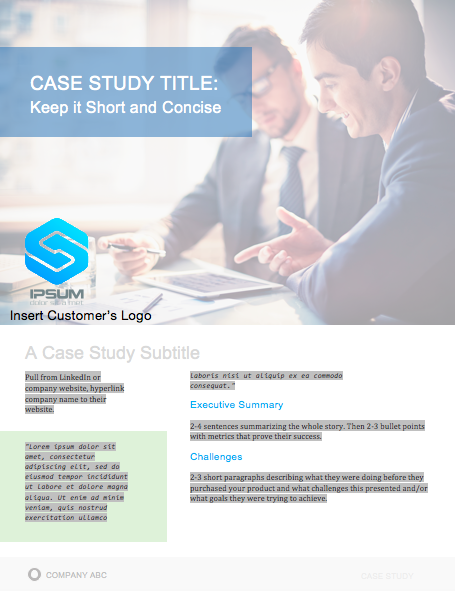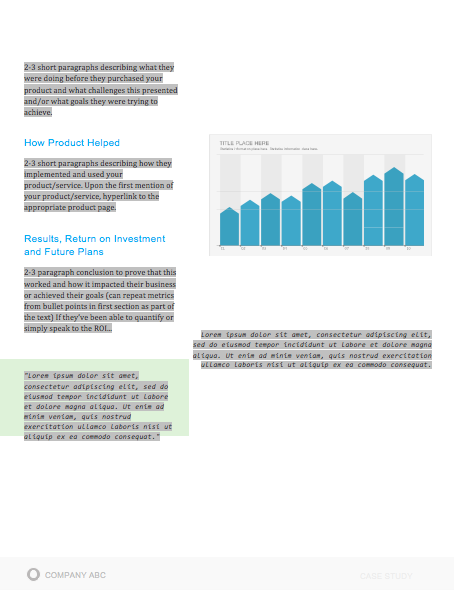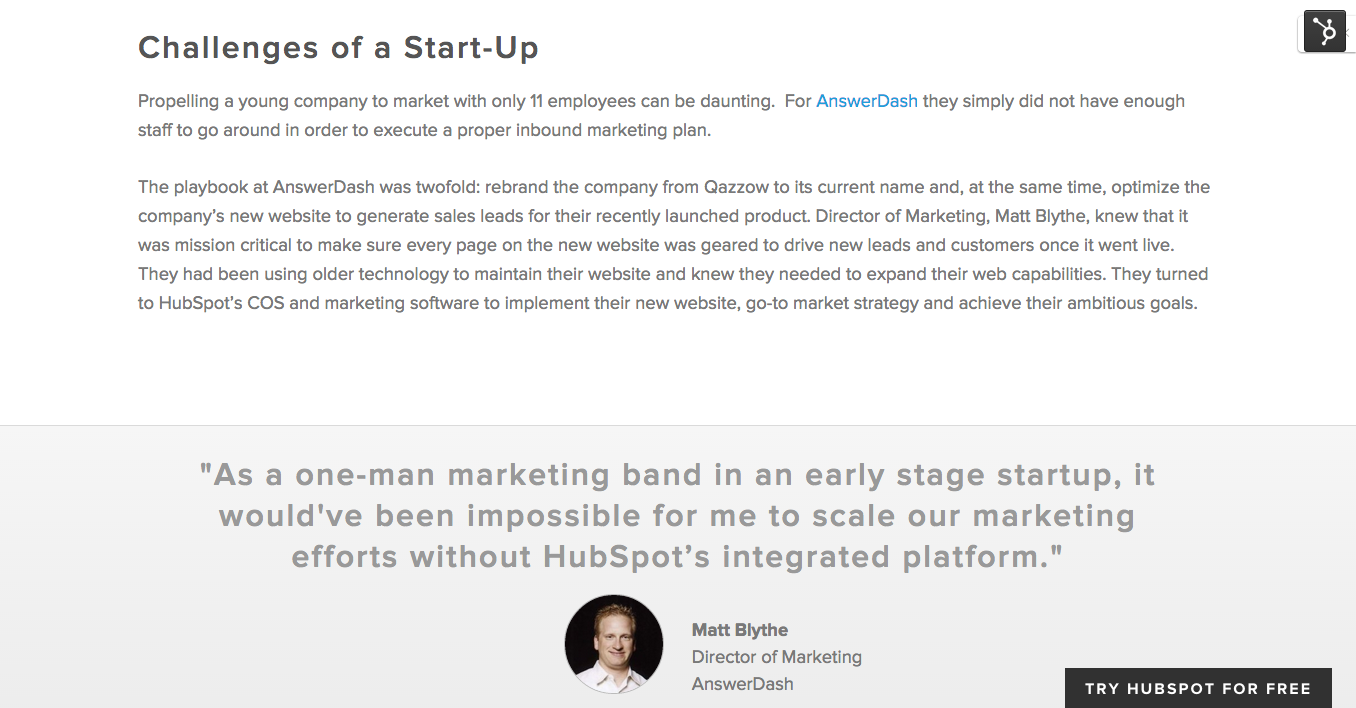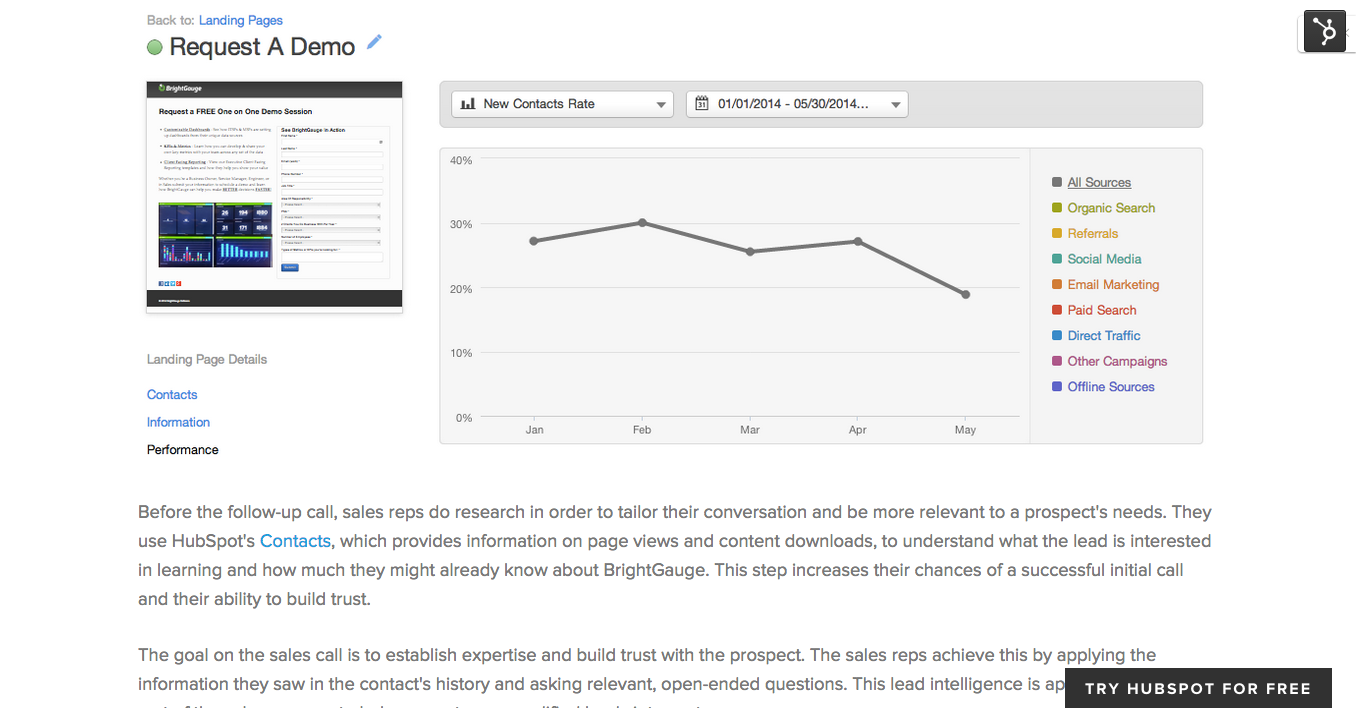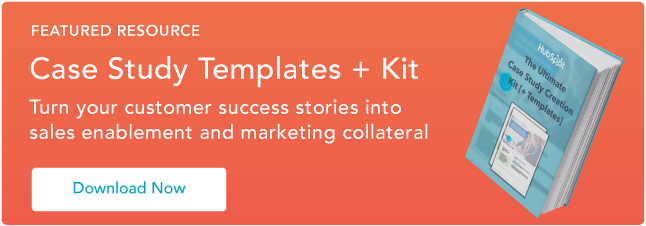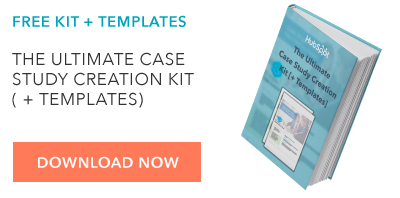
Struggling to earn the trust of potential new customers?
Before you can expect them to open up their wallets, you need to start the sales process by demonstrating your ability to deliver on what your product or service promises.
Sure, you could tell them that you’re great at X and that you’re light-years ahead of the competition when it comes to Y and Z, but at the end of that day, that’s just lip service. What you really need to win new business is cold, hard proof.
One of the best ways to prove your worth is through the creation of compelling case studies that chronicle the positive impact your product or service has had on one of your existing customers. To help you arm your prospects with information they can trust, we’ve put together a step-by-step guide on how to create effective case studies for your business — as well as a free template for creating case studies of your own.
Download the free case study template here.
How to Write a Case Study: The Ultimate Guide
How to Find the Right Case Study Candidate
In order to provide your sales team with truly valuable case studies, you need to have a definitive plan for selecting the most qualified candidates. Here’s what you should look for in a potential case study candidate:
- Product Knowledge: The more well-versed a customer is in the logistics of your product or service the better. This will help to ensure that they can speak to the value of what you offer in a way that makes sense for future customers.
- Exemplary Results: The companies that have seen the best results are going to make the strongest case studies. Not to mention, if you’ve done really well for them, it’s likely that they’ll have the enthusiasm you’re looking for.
- Unexpected Success: Non-traditional customers that have seen positive results can help absolve any doubts potential customers may have.
- Recognizable Names: While small companies can have powerful stories, bigger or more notable brands can help increase credibility.
- Switchers: Customers that came to you after working with a competitor help highlight your competitive advantage and sway decisions in your favor.
How to Reach Out to Case Study Participants
To get the right case study participants on board with the creation process, you have to set the stage for clear and open communication. This means you need to set expectations and determine a well-defined timeline right away.
The biggest reason why the case study process is delayed is due to the customer not having a timeline set or authorization rights to approve the case study, so you want to be sure that you’re covering all of the bases before you get in too deep.
To avoid a delay, you should kick off the introduction with an email that runs through exactly what they can expect from you, as well as what is expected of them. To help you get a better idea of what this should look like, check out this sample email:
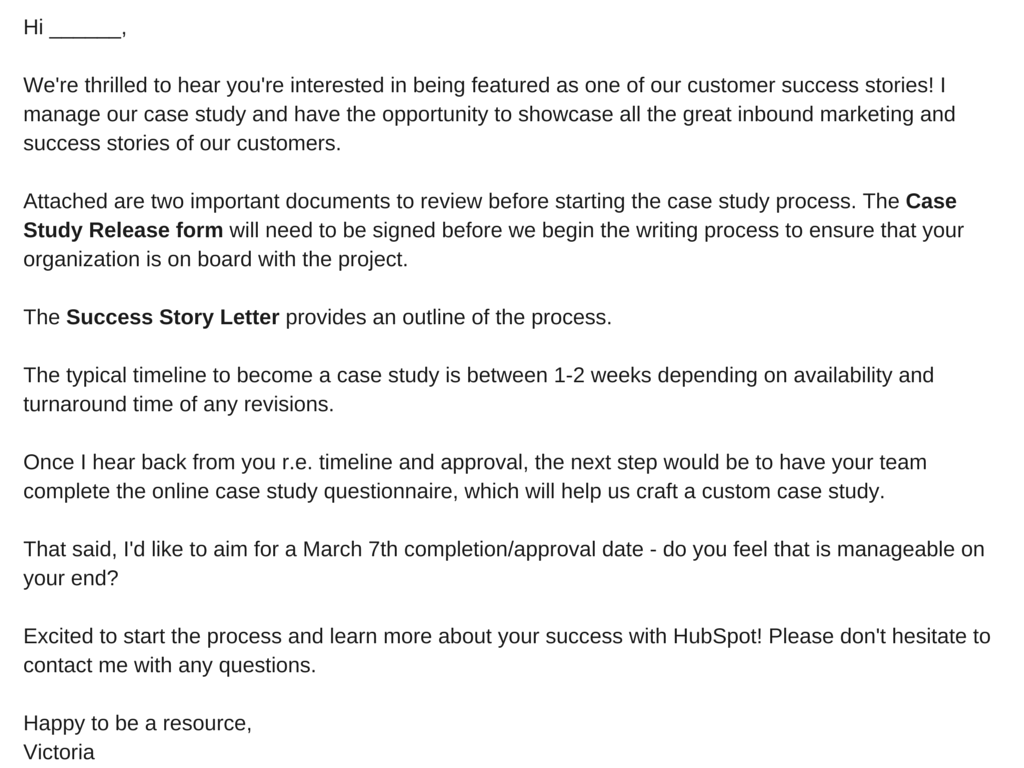
So now you’re probably wondering 1) what’s a Case Study Release Form? and 2) what’s a Success Story Letter?
Let’s start with the Case Study Release Form. It’s important to note that this document will vary depending on factors such as the size of your business, the nature of your work, and what you intend to do with the case studies once they are completed. With that said, here’s what you should typically aim to include in the Case Study Release Form:
- A clear explanation of why you are creating this case study and how it will be used.
- A statement defining the information you expect to include about the company — names, logos, job titles, pictures, etc.
- An explanation of your expectations in terms of their participation beyond the completion of the case study. (Are they willing to act as a reference or share feedback? Do you have permission to pass their contact information along for these purposes?)
- A note about compensation.
As noted in the sample email, The Success Story Letter serves as an outline for the entire case study process. Other than a brief explanation of how the customer will benefit from their case study participation, you’ll want to be sure to define the following steps in The Success Story Letter:
- The Acceptance: First, you’ll need to receive internal approval from the company’s marketing team. Once approved, you’ll want them to send over the signed Release Form. This is also a good time to determine a timeline that meets the needs and capabilities of both teams.
- The Questionnaire: To ensure that you have a productive interview, you’ll want to ask the participant to complete a questionnaire prior to their phone interview. This will provide your team with the foundation they need to organize the interview and get the most out of it.
- The Interview: Once the questionnaire is completed, someone on your team should reach out to the participant to schedule a 30-60 minute interview. The interview will cover a series of custom questions related to the customer’s experience with your product or service.
- The Draft Review: After the case study is composed, you’ll want to send a draft to the customer to give them with an opportunity to provide feedback and edits.
- The Final Approval: Once any necessary edits are completed, you should send a revised copy of the case study to the customer for final approval.
After the page goes live, it’s best to follow up with the customer and send them a link to the page where the case study lives. Don’t be afraid to ask them to share the link with their network, as it demonstrates not only your ability to deliver positive result, but their impressive growth as well.
How to Ensure You’re Asking the Right Questions
When it comes time to execute on the questionnaire and actual interview, you want to be sure that you’re setting yourself up for success. In order to end up with a strong use case, it’s important that you’re prepared to not only ask questions, but also ask the right questions.
In terms of the questionnaire, here are a few sample questions to get you started:
- What are your goals?
- What challenges were you experiencing prior to purchasing our product or service?
- What made our product or service stand out against our competitors?
- What did your decision-making process look like?
- How have you benefited from using our product or service? (Ask for specific numbers if applicable.)
Keep in mind that the questionnaire is designed to help you turn up the insight you need to ask strong, success-focused questions during the actual interview.
As for the phone interview, we recommend that you follow the “Golden Rule of Interviewing.”
Sounds fancy, right?
It’s actually quite simple: Ask open-ended questions.
If you’re looking to craft a compelling story, yes or no answers are going to get you nowhere. It’s critical to maintain a focus on questions that invite elaboration such as “can you describe …” or “tell me about …”
In terms of a structure for the interview, we recommend breaking down the process into six specific sections — The Customer’s Business, The Need for a Solution, The Decision Process, The Implementation, The Solution in Action, and The Results. These focus areas allow us to gather enough information to put together a rich, comprehensive study.
Here’s a deeper dive into what these sections look like:
- The Customer’s Business: The goal of this section is to generate a better understanding of the company’s current challenges and goals, and how they fit into the landscape of their industry.
- Sample questions: How long have you been in business? How many employees do you have? What are some of the objectives of your department at this time?
- The Need for a Solution: In order to tell a compelling story, you need context. This helps match the customer’s need with your solution.
- Sample questions: What challenges and objectives led you to look for a solution? What would have happened if you did not identify a solution? Did you explore other solutions prior to this that did not work out? If so, what happened?
- The Decision Process: Exploring how the customer arrived at their decision to work with you helps to guide the decision-making process of potential customers.
- Sample questions: How did you hear about our product or service? Who was involved in the selection process? What was most important to you when evaluating your options?
- The Implementation: Your focus should be on exploring their experience during the onboarding process.
- Sample questions: How long did it take to get up and running? Did that meet your expectations? Who was involved in the process?
- The Solution in Action: The goal of this section is to better understand how the customer is using your product or service.
- Sample questions: Is there a particular aspect of the product or service that you rely on most? Who is using the product or service?
- The Results: This is where you want to uncover impressive measurable outcomes. The more numbers, the better.
- Sample questions: How is the product or service helping you save time and increase productivity? In what ways does this enhance your competitive advantage? How much have you increased metrics X, Y, and Z?
How to Lay Out Your Case Study: Sample Case Study Format
When it comes time to take all of the information you’ve collected and actually turn it into something, it’s easy to feel overwhelmed.
Where should you start? What should you include? What’s the best way to structure it?
To help you get a handle on the layout, we recommend focusing on building out the following seven sections:
- Title: Keep it short. Focus on highlighting the most compelling accomplishment.
- Executive Summary: This should be a 2-4 sentence summary of the entire story. You’ll want to follow it with 2-3 bullet points that display metrics showcasing success.
- About: This serves as an introduction to the person or company and can be pulled from their LinkedIn profile or website.
- Challenges: This section should include 2-3 paragraphs describing the customer’s challenges prior to using your product or service, as well as the goals that they set out to achieve.
- How You Helped: This section should include 2-3 paragraphs that focus on describing how your product or service provided a solution to their problem.
- Their Results: This section should include 2-3 paragraphs that prove how your product or service specifically impacted the person or company and helped them achieve their goals. Include numbers to quantify your contributions.
- Supporting Visuals or Quotes: Pick one or two powerful quotes that you would feature at the bottom of sections above, as well as a visual that supports the story you are telling.
To help you visualize this case study format, check out the following case study template.
You also can download this template here.
When laying out your case study, you should be focused on conveying the information that you’ve gathered in the most clear and concise way possible. Make it easy to scan and comprehend, and most importantly, be sure to provide an attractive call-to-action at the bottom to provide readers with an opportunity to learn more about your product or service.
Business Case Study Examples
You drove the results, made the connect, set the expectations, used the questionnaire to conduct a successful interview, and boiled down your findings into a compelling story. And after all of that, you’re left with a little piece of sales enabling gold: a case study.
To illustrate what you can expect the final product to look like, take a look at some of these marketing case study examples from HubSpot’s case study library:
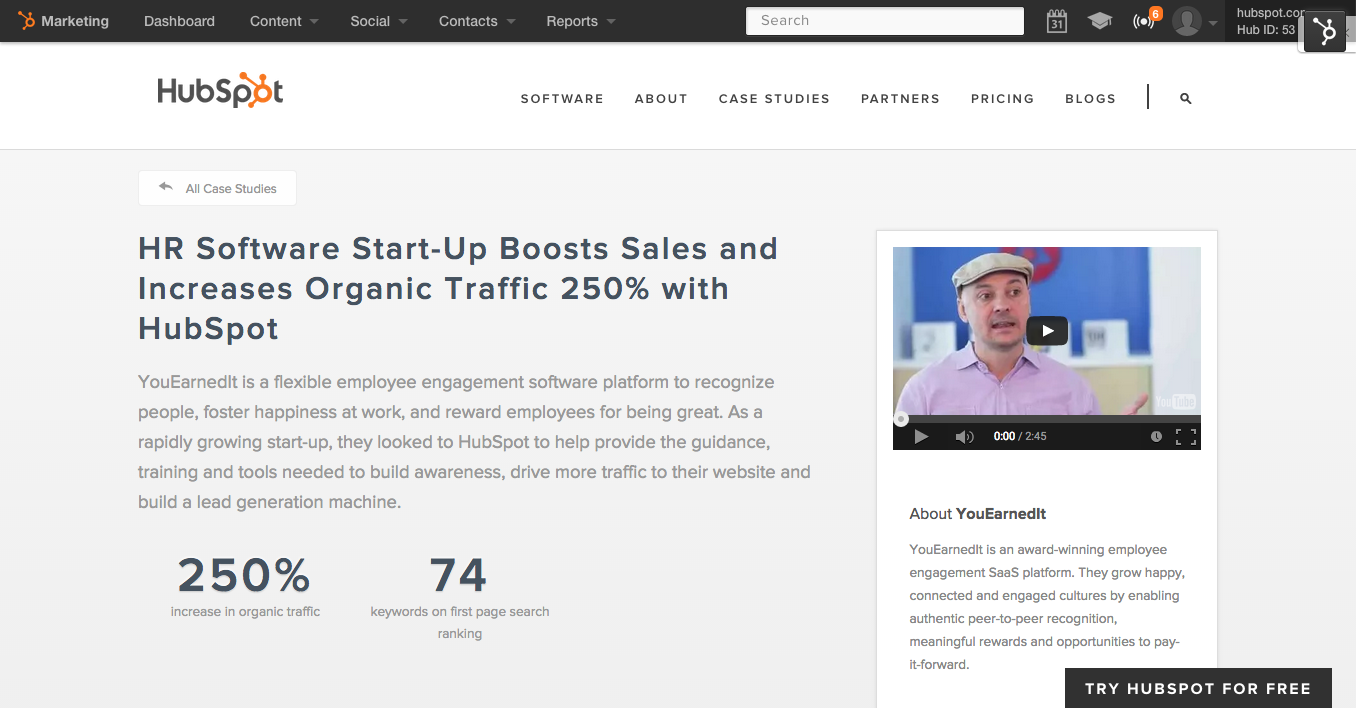
Notice how the title employs a compelling number that entices the reader to further explore how YouEarnedIt achieved said success?
See how the powerful quotes work to add additional support throughout the study?
Notice how the visual elements help to demonstrate success and provide readers with a better understanding of what your product or service is capable of?
How does your company approach the case study creation process? What unique ways do you promote your case studies? Let us know in the comments below.
Editor’s Note: This post was originally published in June 2012 and has been updated for freshness, accuracy, and comprehensiveness.
![]()
